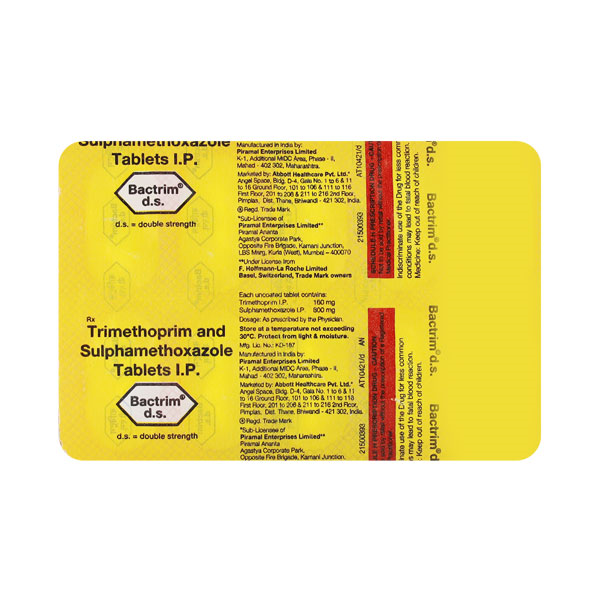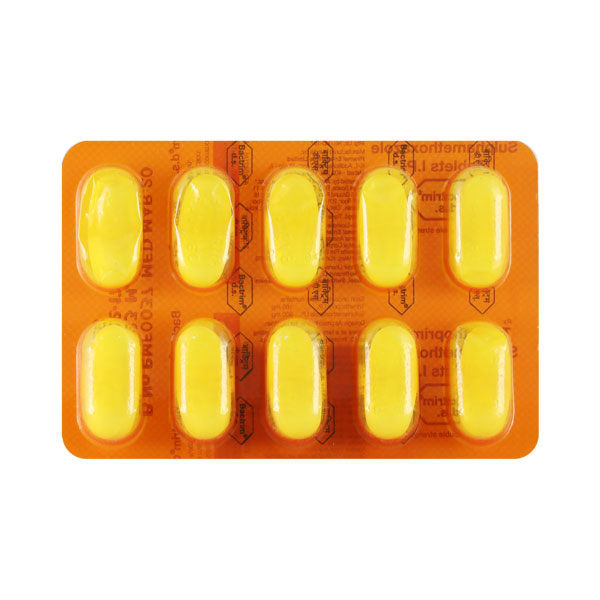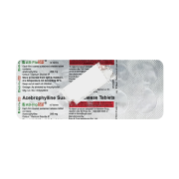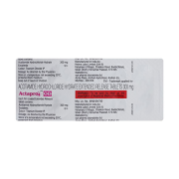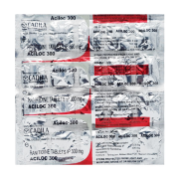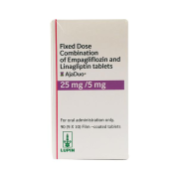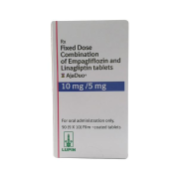Bactrim DS Tablet 10'S
Sulphamethoxazole 800 mg+Trimethoprim 160 mg
₹ 23.00
₹26
(Inclusive of all taxes)
-

No Warranty
-

COD Avilable
-

Non Returnable
-

cancelable
About this item
INTRODUCTION ABOUT BACTRIM DS TABLET
BACTRIM DS TABLET is a combination of Sulphamethoxazole and Trimethoprim, which belong to the group of medicines called Antibiotics. It is used to manage lung infections (pneumonia or Pneumocystis jiroveci pneumonia) caused by a bacteria called Pneumocystis jirovecii and toxoplasmosis (infection with the Toxoplasma gondii parasite).
It can also be used to manage urinary tract infections, respiratory tract infections (such as bronchitis), ear infections (such as otitis media), and an infection called nocardiosis, which can affect the lungs, skin, and brain. BACTRIM DS TABLET is suitable for use both in adults and in adolescents (aged 12 years or older).
Take BACTRIM DS TABLET for the stipulated duration as instructed by your doctor even if you feel better during the midway of the therapy to achieve better results. Failing to complete the full course of the therapy or skipping doses in between the therapy may not result in adequate infection control.
Before taking BACTRIM DS TABLET inform your doctor if you have any liver or kidney problems. You must also inform your doctor if you have asthma, any allergic conditions, genetic disorders, blood-related disorders, folic acid deficiency, high blood potassium levels or if you are malnourished as a precaution.
Consult your doctor before taking this medicine if you are pregnant or breastfeeding. The most common side effects of taking BACTRIM DS TABLET are headaches, nausea, diarrhea, high blood potassium levels, fungal infections of the mouth or vagina, and skin rashes. Consult your doctor if any of these side effects trouble you.
USES OF BACTRIM DS TABLET
It is used in adults and in adolescents (aged 12 years or older) to manage the following bacterial infections:
- Lung infections (Ex. Pneumonia or Pneumocystis jiroveci pneumonia) are caused by a bacteria called Pneumocystis jirovecii
- Toxoplasmosis (an infection with the Toxoplasma gondii parasite)
- Urinary tract infections
- Respiratory tract infections (Ex. bronchitis)
- Ear infections (Ex. otitis media)
- Nocardiosis (a bacterial infection that affects the lungs, skin, and brain)
HOW BACTRIM DS TABLET WORKS
BACTRIM DS TABLET is a powerful antibiotic. It kills the susceptible bacteria by blocking the production of certain essential vitamins (folate) that are necessary for the bacteria to grow, multiply and survive. Therefore, it destroys the susceptible bacteria and manages their further growth and multiplication within the body which helps in reducing the severity of the infection.
DIRECTIONS FOR USE
Take BACTRIM DS TABLET as advised by your physician. Swallow BACTRIM DS TABLET with a glass of water. Do not crush or chew the medicine. BACTRIM DS TABLET can be taken with or without food.
Your doctor will decide the correct dose and duration of therapy for you depending on your age, body weight, and severity of the infection.
Do not stop taking BACTRIM DS TABLET once your symptom subsides. It is important to take BACTRIM DS TABLET for the stipulated duration as recommended by your doctor to achieve better results.
SIDE EFFECTS OF BACTRIM DS TABLET
COMMON
- high potassium levels in blood causing abnormal heartbeats
- fungal infection (thrush or candidiasis) of mouth or vagina
- headache, nausea, diarrhoea
- skin rashes
UNCOMMON
- vomiting
RARE
Stop taking BACTRIM DS TABLET and contact your doctor immediately if you experience any of the following side effects:
- severe allergic reactions (such as skin rashes, itching, swelling of the face, lips, tongue or throat causing difficulty in breathing or swallowing, chest pain and fainting)
- severe skin reactions (such as generalised skin redness with pustules accompanied by fever, ulcers in the mouth, throat, nose, genitals, red, swollen eyes, severe skin rash with blistering and peeling of skin, red pinpoint targets under the skin)
- signs of abnormal WBC count (such as fever, swollen glands, weakness, light-headedness, shortness of breath, bruising with or without skin rash)
- unexpected worsening of cough and shortness of breath
HOW TO MANAGE SIDE EFFECTS
Diarrhea
Drink plenty of fluids, such as water or fruit juice to keep yourself hydrated. Consuming ORS can also be beneficial. Do not consume any medicine on your own without consulting your doctor. If your diarrhea worsens, contact your doctor immediately.
Headache
Rest and relax. Keep yourself hydrated by drinking plenty of fluids such as water or electrolytes. Applying a pain-relieving balm on your forehead can be beneficial. Do not consume excessive alcohol, as it could aggravate your headache. Consult your doctor if your headache worsens.
Nausea And Vomiting
Take BACTRIM DS TABLET with, or just after meals. Stick to simple meals. Avoid eating oil-rich or spicy foods. Please consult your doctor immediately if you experience severe nausea and vomiting.
WARNING & PRECAUTIONS
PREGNANCY
Use with CautionBACTRIM DS TABLET should be used with caution in pregnant women. Therefore, consult your doctor for advice before taking it.
BREASTFEEDING
Use with CautionBACTRIM DS TABLET should be used with caution in breastfeeding women. Therefore, consult your doctor for advice before taking it.
DRIVING AND USING MACHINES
ContraindicatedDo not drive or operate any heavy tools or machines if your ability is affected by BACTRIM DS TABLET.
ALCOHOL
ContraindicatedAvoid consumption of alcohol while taking BACTRIM DS TABLET.
KIDNEY
Consult your doctorBACTRIM DS TABLET is not recommended for use in patients with severe kidney problems. It should be used with caution in patients with other kidney problems. Therefore, consult your doctor before taking it.
LIVER
ContraindicatedBACTRIM DS TABLET is not recommended for use in patients with severe liver problems. Therefore, consult your doctor before taking it.
ALLERGY
ContraindicatedDo not take BACTRIM DS TABLET if you are allergic to Sulphamethoxazole, trimethoprim, sulphonamide medicines (such as gliclazide, glibenclamide) or to thiazide diuretics (such as Bendroflumethiazide).
LUNGS
Use with CautionBACTRIM DS TABLET should be used with caution in patients with asthma. Therefore, consult your doctor before taking it.
USE IN PEDIATRICS
ContraindicatedBACTRIM DS TABLET is not recommended for use in children and adolescents (aged below 12 years). However, consult your doctor for advice before taking it.
USE IN GERIATRICS
Use with CautionBACTRIM DS TABLET should be used with caution in elderly patients. Therefore, consult your doctor for advice before taking it.
OTHERS
BACTRIM DS TABLET is not recommended for use if you:
- Ever had bleeding problems (such as thrombocytopenia)
- Have porphyria (a rare blood disorder)
Before taking BACTRIM DS TABLET, consult your doctor if you:
- Have any allergic conditions (such as watery eyes, an itchy nose, or repeated sneezing)
- Have anemia or a vitamin B9 (folic acid) deficiency
- Have G6PD deficiency (a genetic disorder that affect metabolism)
- Have phenylketonuria (the buildup of an amino acid called phenylalanine in the body)
- Are underweight or malnourished
- Have high blood potassium levels
- Have very low RBC, WBC, and platelet counts in the blood
INTERACTIONS
A. Drug-Drug Interactions:
Before taking BACTRIM DS TABLET, inform your doctor if you are taking any of the following medicines, such as:
- Diuretics (medicines used to remove excess water from the body) such as furosemide and hydrochlorothiazide
- Pyrimethamine (a medicine used to manage malaria)
- Medicines used for blood thinning (such as warfarin)
- Phenytoin (a medicine used to manage epilepsy)
- Medicines used to manage diabetes (such as glibenclamide, glipizide, tolbutamide, or repaglinide)
- Rifampicin (an antibiotic used to manage tuberculosis)
- Medicines used to manage heart problems (such as digoxin or procainamide)
- Amantadine (a medicine used to manage Parkinson’s disease)
- Medicines used to manage HIV infections (such as zidovudine or lamivudine)
- Medicines that can increase the amount of potassium in the blood, such as potassium-sparging diuretics (Ex. spironolactone, acetazolamide), certain steroids (like prednisolone), or ACE inhibitors (Ex. captopril, enalapril, and lisinopril)
- Medicines used to suppress immune function and graft rejection (such as ciclosporin and azathioprine)
- Methotrexate (a medicine used to manage certain cancers or joint pain)
- Folinic acid (a type of vitamin B9 supplement)
- Contraceptive medicines (birth control pills) Ex. ethinylestradiol, Dydrogesterone
B. Drug-Food Interaction:
BACTRIM DS TABLET is preferably taken with meals to avoid unwanted stomach problems. However, it can also be taken on an empty stomach. Avoid consuming foods rich in potassium while taking this medicine.
Overdosage:
If you or anyone else accidentally took more BACTRIM DS TABLET, consult your doctor immediately or visit the nearby hospital. Symptoms of overdosage might include nausea, vomiting, dizziness, and confusion.
SYNOPSIS
| Drug | : | Sulphamethoxazole, Trimethoprim |
| Pharmacological Category | : | Sulphonamides, Diaminopyrimidine |
| Therapeutic Indication | : | Bacterial Infections |
| Dosage Forms | : | Tablet, Syrup, Suspension, Injection, Infusion, Eye drops |
MORE INFORMATION
- Keep BACTRIM DS TABLET out of reach of children
- Store BACTRIM DS TABLET at room temperature
0 Review Of Product Bactrim DS Tablet 10'S

